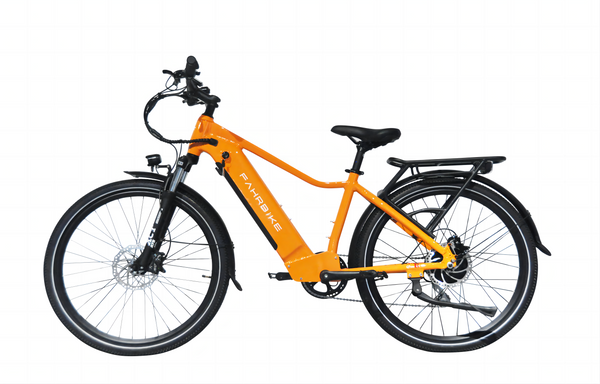It's time to remind you of the rules and legislation pertaining to e-bikes because more and more individuals are buying electric fat bikes. State laws govern how e-bikes can be used on sidewalks, public roadways, and other surfaces, and these laws differ from one state to the next. It implies that drivers must abide by the local traffic laws in their communities. We'll talk about the regulations in a few states today because certain areas of the country haven't yet made their e-bike policies apparent.
A "low-speed electric bicycle" is a two- or three-wheeled vehicle with fully functional pedals, a top speed when powered alone by the motor under 20 mph (32 km/h), and an electric motor that produces less than 750 W, according to the federal Consumer Product Safety Act. Both local and federal regulations must be followed by all of them.

The chart that follows shows some of the fundamental regulations for e-bikes in several American states. You can read more about each topic further on in the article.
Max Speed: The fastest possible speed when using only the motor.
Max Power: Maximum motor power, or engine size, permitted.
| States | Max speed | Max power | Helmet | Min age | Driver's license |
| Arizona | 20 | 48cc | No | None | No |
| California | 20 | 750W | Class 1 dependent | Class dependent | No |
| Colorado | 20 | 750W | No | None | No |
| Idaho | 30 | < 2 brake hp | No | 16 | Yes |
| Montana | 30 | 50cc | Under 18 | No | |
| New Mexico | Under 18 | No | |||
| Nevada | 20 | 750W | No | No | |
| Oklahoma | 20 | 1000W | Under 16 | 16 | No |
| Oregon | 20 | 1000W | Under 16 | 16 | No |
| Texas | 20 | None | No | None | No |
| Utah | 20 | 750W | No | 8 (accompanied by parent/guardian), 14 (unaccompanied) |
No |
| Washington | 28 | 750W | No | 16, for class3 | No |
| Wyoming | 20 mph&28 mph for class3 | 50cc | Yes |
In the US, e-bikes are divided into four categories.
Class 1: Pedal-Assist, Class 2: Throttle on Demand, Class 3: Speed Pedal-Assist, and Class 4: Motorcycle or Moped.
Arizona:
According to Arizona legislation, electric bicycles may be used on roads reserved exclusively for bicycles as well as multi-use trails intended for hiking, biking, horseback riding, or other non-motorized uses, unless expressly forbidden. Although it is not necessary to have an operator's licence to ride a bicycle on Arizonan roadways, you must have identification.
California:
E-bikes are subject to the same regulations as bicycles in California. The same traffic laws apply to both human-powered and electric bicycles. The registration, licencing, and insurance procedures that are applicable to motor vehicles do not apply to e-bikes.
Colorado:
The HR 727 National Law's definition of an e-bike is 20 mph (30 km/h) e-power and 750 W maximum. If not forbidden by municipal regulation, legal low-powered e-bikes are not allowed to use their motors on bike and pedestrian routes but are permitted in bike lanes and on the road.
Montana:
As of April 21, 2015, mopeds in Montana are now considered bicycles and do not require a driver's licence. For further information, see the bicycle law.
Nevada:
As of May 19, 2009, Nevada amended its state transportation laws to specifically allow electric bicycles to use any "trail or pedestrian walkway" designed for use with bicycles and built with federal funding, as well as generally allowing electric bicycles to be operated in situations where a regular bicycle could be.
New Mexico:
There are no particular regulations governing motorised or electric bicycles in New Mexico. According to MVD regulations, powered bicycles are treated exactly like bicycles and don't need registration or a driver's licence.
Oregon:
According to Oregon law, an electric-assisted bicycle is one with no more than three wheels in actual contact at any given time, an operational set of pedals, and a seat or saddle for the rider. In addition, the car needs to have an electric motor that can't move it faster than 20 mph on flat terrain and that can only apply a power output of no more than 1,000 watts.
Texas:
Bicycles that are propelled by an electric motor and have a top speed of 20 MPH on flat ground are referred to as electric bicycles in the state of Texas. You can ride one without a licence or any other documentation, but you cannot drive on interstates.
Utah:
According to Utah legislation, an e-bike is a regular pedal bike that has an assisted motor and is pushed by human power. The registration, licencing, and insurance procedures that are applicable to motor vehicles do not apply to e-bikes. On bike lanes but not on sidewalks, e-bikes are permitted.
Washington:
All types of electric bicycles are permitted to be used on fully controlled, limited-access highways in Washington. However, Class 3 bicycles "may not be used on a sidewalk unless there is no alternative to ride over a sidewalk as part of a bicycle or pedestrian way." Class 1 and Class 2 electric bicycles are permitted to be used on sidewalks. In general, unless specifically permitted, a person may not ride an electric-assisted bicycle on a trail that is classified as non-motorized and that has a natural surface.
A Final Word
More individuals are turning to buying e-bikes as a result of the increased restrictions on using internal combustion engines in the US. When operating our Fahrbike electric fat bike, it is necessary to be aware of the applicable local laws and traffic regulations.





